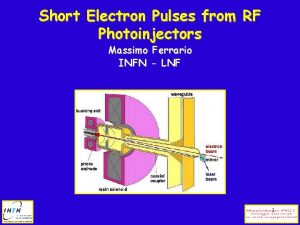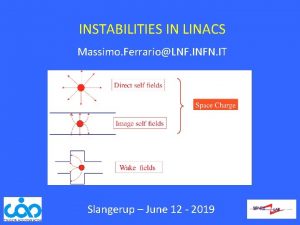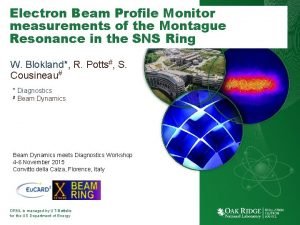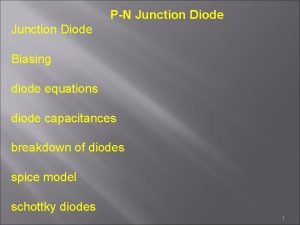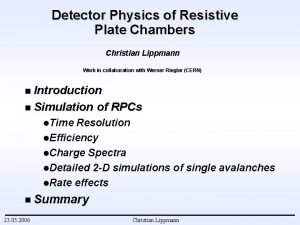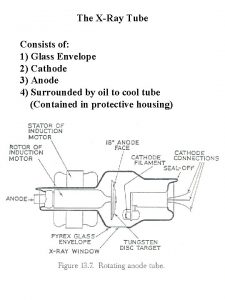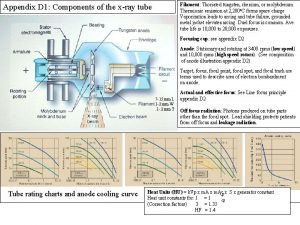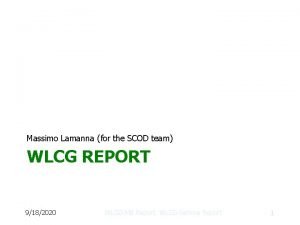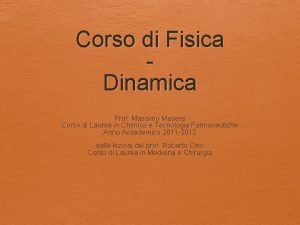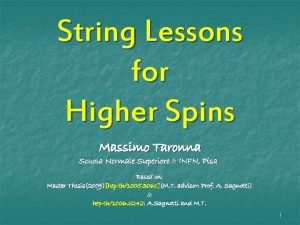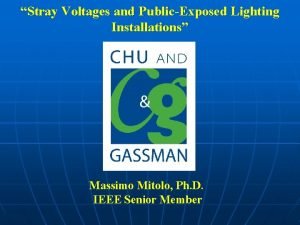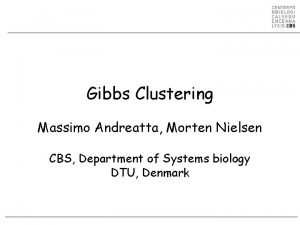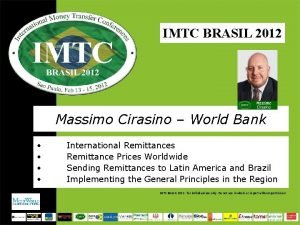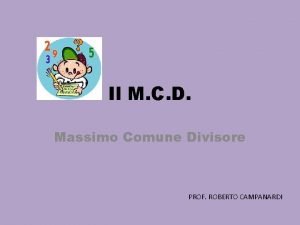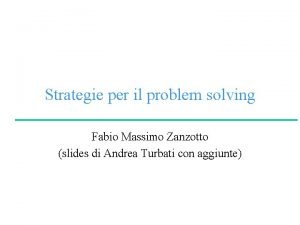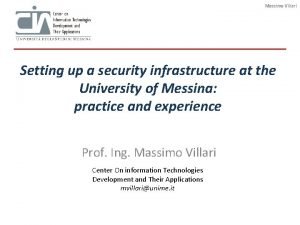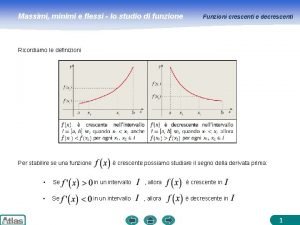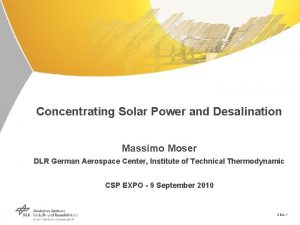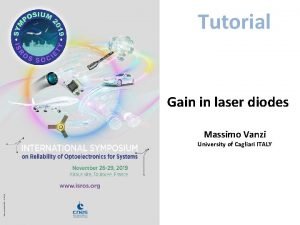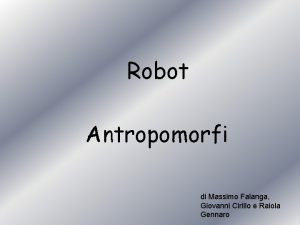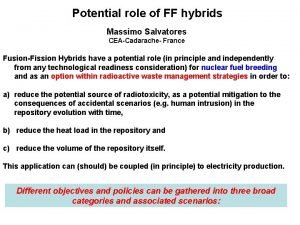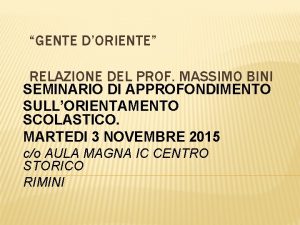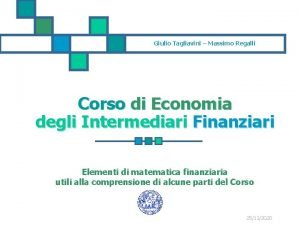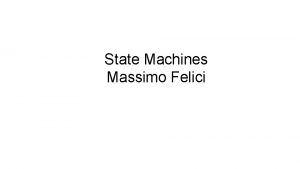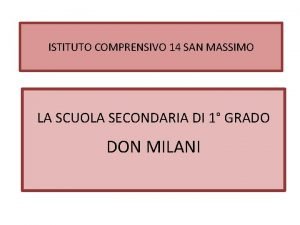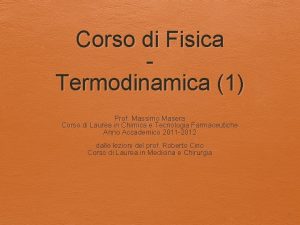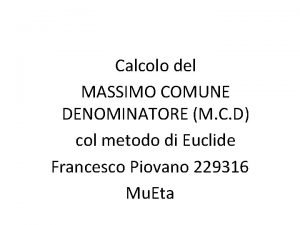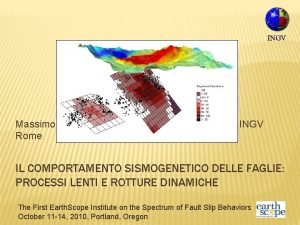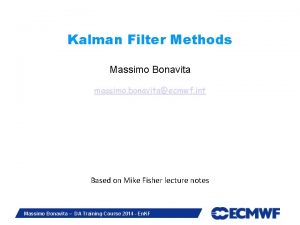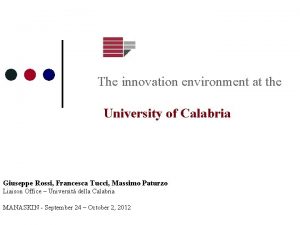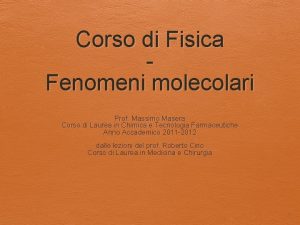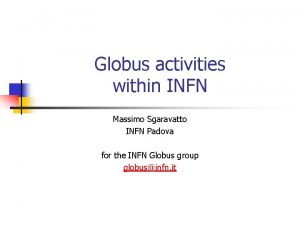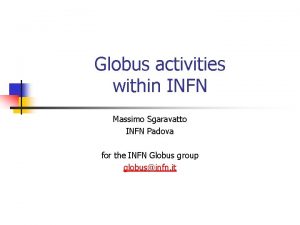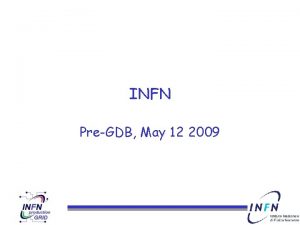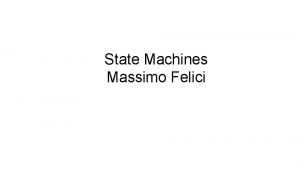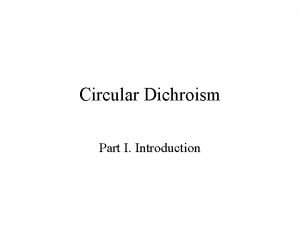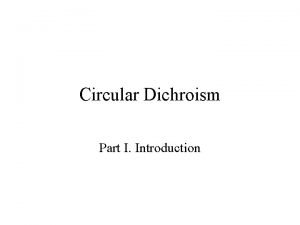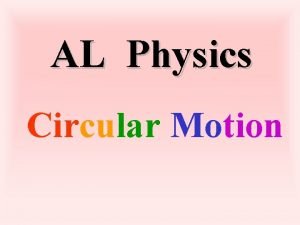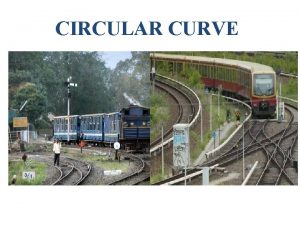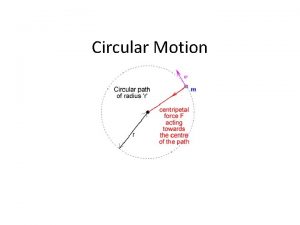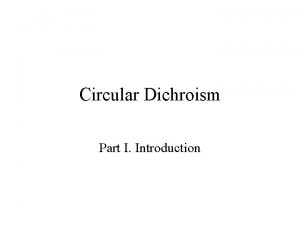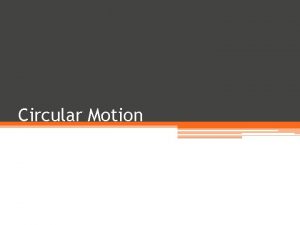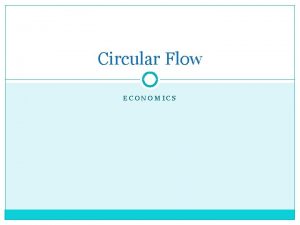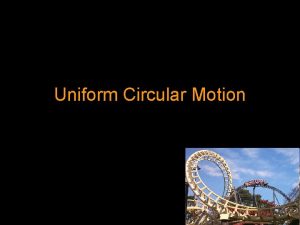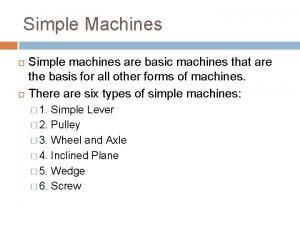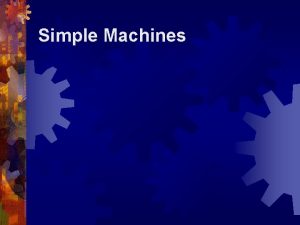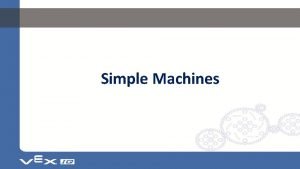SPACE CHARGE IN CIRCULAR MACHINES Massimo FerrarioLNF INFN












































- Slides: 44

SPACE CHARGE IN CIRCULAR MACHINES Massimo. Ferrario@LNF. INFN. IT Slangerup – June 12 - 2019

OUTLINE • Direct Space Charge Effects • The rms emittance concept • rms envelope equation • Space charge forces • Beam (Plasma) emittance oscillations • Intra-beam scattering IBS • Image Charge Effects • Image self fields • Space charge effects in Storage Rings

Space Charge: what does it mean? The net effect of the Coulomb interactions in a multi-particle system can be classified into two regimes: 1) Collisional Regime ==> dominated by binary collisions caused by close particle encounters ==> Single Particle Effects 2) Space Charge Regime ==> dominated by the self field produced by the particle distribution, which varies appreciably only over large distances compare to the average separation of the particles ==> Collective Effects

A measure for the relative importance of collisional versus collective effects is the: Debye Length D Let consider a non-neutralized system of identical charged particles We wish to calculate the effective potential of a fixed test charged particle surrounded by other particles that are statistically distributed. Magnetic focusing

The effective potential of a test charge can be defined as the sum of the potential of the single particle and a “perturbation” term n. From Poisson Equation: N => total number of particles n => particle number density (N/V) k. B=> Boltzman constant T => Temperature k. B T => average kinetic energy of the particles

the effective interaction range of the test particle is limited to the Debye length The charges sourrounding the test particles have a screening effect D Smooth functions for the charge and field distributions can be used as long as the Debye length remains small compared to the particle bunch size


In a charged particle beam moving at a longitudinal relativistic velocity, assuming that the random transverse motion in the beam is non-relativistic, the Debye length has the following form: D [mm] x R=1 mm, L=3 mm Q=1 n. C, T=103 K Electron bunch z

Collisional regime 1) Collisional Regime ==> dominated by binary collisions caused by close particle encounters ==> Single Particle Effects 1) multiple small-angle scattering events Intra-Beam Scattering (IBS) 1) large-angle single scattering events Touschek Effect

Liouville theorem does not hold anymore under Collisions => non Conservative forces involved




Beam Thermodynamics Definition of beam temperature in analogy with kinetic theory of gases : transverse longitudinal In a Circular machine when a particle accelerates above transition energy it becomes slower and behaves like a particle with negative mass:

Conservation Law Let us first consider the ideal machine with a smooth-focusing lattice below transition and negligible dispersion. The total thermal energy per particle in a smooth linear beam channel is conserved, for a beam with constant energy (γ 0 = const) Coulomb collisions drive the beam toward an isotropic thermal equilibrium, in which case three temperatures would be the same: We can put the conservation law into the form:

in a circular machine we must replace 1/ o by: This relationship is the invariant for intra-beam scattering derived in 1974 by Piwinski. For a circular machine the behavior of the system depends on the sign of η i. e. whether it is below transition (γ 0 < γt) or above (γ 0 > γt ). below transition η < 0 thermal equilibrium can be reached. above transition η > 0 thermal equilibrium is not possible. An increase in momentum spread must be balanced by a corresponding increase in the transverse emittances to maintain the “conservation law”

The growth rate for intra-beam scattering in high-energy circular machines defined as: can be written in the relativistic form

Touschek Effect In a relativistic storage ring, Coulomb collisions lead to a momentum transfer from the transverse into the longitudinal direction that is amplified by the Lorentz factor γo While the total momentum in the collision is preserved, the two particles emerge from this collision with opposite longitudinal momentum components that are larger by the factor γo than the original transverse momentum component before the collision.

If the longitudinal momentum acquired in such a collision is greater than the momentum acceptance of the rf bucket that keeps the beam longitudinally bunched, the two particles involved in such a collisions will be lost. The net result is that the lifetime of the stored beam is reduced.



OUTLINE • Direct Space Charge Effects • The rms emittance concept • rms envelope equation • Space charge forces • Beam (Plasma) emittance oscillations • Image Charge Effects • Image self fields • Space charge effects in Storage Rings

IMAGE SELF FIELDS Direct self fields Space Charge Image self fields Wake fields

Static Fields: conducting screens Let us consider a point charge q close to a conducting screen. The electrostatic field can be derived through the "image method". Since the metallic screen is an equi-potential plane, it can be removed provided that a "virtual" charge is introduced such that the potential is constant at the position of the screen q q -q

A constant current in the free space produces circular magnetic field If r 1, the material, even in the case of a good conductor, does not affect the field lines. I

Circular Perfectly Conducting Pipe (Beam at Center) there is a cancellation of the electric and magnetic forces

Parallel Plates (beam at center) In some cases, the beam pipe cross section is such that we can consider only the surfaces closer to the beam, which behave like two parallel plates. In this case, we use the image method to a charge distribution of radius a between two conducting plates 2 h apart. By applying the superposition principle we get the total image field at a position y inside the beam. q 4 h -q 2 h 2 h qy -q Where we have assumed: h>>a>y. q For d. c. or slowly varying currents, the boundary condition imposed by the conducting plates does not affect the magnetic field. We do not need “image currents “As a consequence there is no cancellation effect for the fields produced by the "image" charges.

From the divergence equation we derive also the other transverse component, notice the opposite sign: Including also the direct space charge force, we get: Therefore, for >>1, and for d. c. or slowly varying currents the cancellation effect applies only for the direct space charge forces. There is no cancellation of the electric and magnetic forces due to the "image" charges.

Time-varying fields It is necessary to compare the wall thickness and the skin depth (region of penetration of the e. m. fields) in the conductor. w w If the fields penetrate and pass through the material, we are practically in the static boundary conditions case. Conversely, if the skin depth is very small, fields do not penetrate, the electric filed lines are perpendicular to the wall, as in the static case, while the magnetic field line are tangent to the surface. I I -I -I

w Parallel Plates (Beam at Center) a. c. currents w Usually, the frequency beam spectrum is quite rich of harmonics, especially for bunched beams. It is convenient to decompose the current into a d. c. component, I, for which w>> w, and an a. c. component, Î, for which w<< w. While the d. c. component of the magnetic field does not perceives the presence of the material, its a. c. component is obliged to be tangent at the wall. For a charge density we have I= v. We can see that this current produces a magnetic field able to cancel the effect of the electrostatic force.

I -I I There is cancellation of the electric and magnetic forces !!

D. C. a A. C. ( w<< w) r -L. J. Laslett, LBL Document PUB-6161, 1987, vol III

OUTLINE • Direct Space Charge Effects • The rms emittance concept • rms envelope equation • Space charge forces • Beam (Plasma) emittance oscillations • Image Charge Effects • Image self fields • Space charge effects in Storage Rings

Incoherent and Coherent Transverse Effects When the beam is located at the centre of symmetry of the pipe, the e. m. forces due to space charge and images cannot affect the motion of the centre of mass (coherent), but change the trajectory of individual charges in the beam (incoherent). These force may have a complicate dependence on the charge position. A simple analysis is done considering only the linear expansion of the self-fields forces around the equilibrium trajectory.

Self Fields and betatron motion Consider a perfectly circular accelerator with radius x. The beam circulates inside the beam pipe. The transverse single particle motion in the linear regime, is derived from the equation of motion. Including the self field forces in the motion equation, we have

Self Fields and betatron motion In the analysis of the motion of the particles in presence of the self field, we will adopt a simplified model where particles execute simple harmonic oscillations around the reference orbit. This is the case where the focussing term is constant. Although this condition in never fulfilled in a real accelerator, it provides a reliable model for the description of the beam instabilities Qx , Betatron tune is the n. of betatron oscillations per turn:

Transverse Incoherent Effects We take the linear term of the transverse force in the betatron equation: The shift of betatron wave numbers (tune shift) is negative since the space charge forces are defocusing on both planes. Notice that the tune shift is, in general, function of “z”, therefore we have also a tune spread inside the beam. Furthermore, by including higher order terms in the transverse force, we don’t have the harmonic oscillator equation any more.

Example: Incoherent betatron tune shift for an uniform electron beam of radius a, length lo, inside circular perfectly conducting pipe For a real bunched beams the space charge forces, and the tune shift depend on the longitudinal and radial position of the charge.

Consequences of the space charge tune shifts In circular accelerators the values of the betatron tunes should not be close to rational numbers in order to avoid the crossing of linear and non-linear resonances where the beam becomes unstable. The tune spread induced by the space charge force can make hard to satisfy this basic requirement. Typically, in order to avoid major resonances the stability requires

Transverse Coherent Effects If the beam experiences a transverse deflection kick, it starts to perform betatron oscillations as a whole. The beam, source of the space charge fields moves transversely inside the pipe, while individual particles still continue their incoherent motion around the common coherent trajectory.

Circular Perfectly Conducting Pipe (Beam off Center) d x b - The image charge is at a distance “d” such that the pipe surface is at constant voltage, and pulls the beam away from the center of the pipe.

The effect is defocusing, the horizontal electric image field E and the horizontal force F are: This coherent betatron tune shift, differently from the incoherent one does not depend on the beam size but on the pipe radius and it is inversely proportional to the beam energy.

CERN-2014 -009, pp. 331 -356

 Massimo ferrario infn
Massimo ferrario infn Chao chao slangerup
Chao chao slangerup Move in a circular or semi-circular direction
Move in a circular or semi-circular direction Difference between charge and electric charge
Difference between charge and electric charge Difference between charge and electric charge
Difference between charge and electric charge Space charge effect
Space charge effect Space charge region
Space charge region Rpcs23
Rpcs23 Glass envelope of x-ray tube
Glass envelope of x-ray tube Thoriated tungsten filament
Thoriated tungsten filament Massimo lamanna
Massimo lamanna Massimo galli
Massimo galli Colored pencil techniques worksheet
Colored pencil techniques worksheet Santi tiburzio valeriano e massimo
Santi tiburzio valeriano e massimo Forza normale fisica
Forza normale fisica Massimo taronna
Massimo taronna David belisario
David belisario Massimo mitolo
Massimo mitolo Massimo andreatta
Massimo andreatta Massimo cirasino
Massimo cirasino Massimo comune divisore
Massimo comune divisore Fabio massimo zanzotto
Fabio massimo zanzotto Massimo villari
Massimo villari Flessi massimi e minimi
Flessi massimi e minimi Massimo ligazzolo
Massimo ligazzolo Massimo moser
Massimo moser Massimo verde
Massimo verde Massimo sorbi
Massimo sorbi Fabio massimo zanzotto
Fabio massimo zanzotto Massimo vanzi
Massimo vanzi Massimo gallerani età
Massimo gallerani età Massimo falanga
Massimo falanga Massimo salvatores
Massimo salvatores Massimo bini
Massimo bini Massimo regalli
Massimo regalli Massimo felici
Massimo felici Istituto comprensivo san massimo
Istituto comprensivo san massimo Massimo biasotto
Massimo biasotto Massimo masera
Massimo masera Massimo comune denominatore
Massimo comune denominatore Massimo cocco
Massimo cocco Arduino ide wikipedia
Arduino ide wikipedia Massimo bonavita
Massimo bonavita Massimo paturzo
Massimo paturzo Massimo masera
Massimo masera
